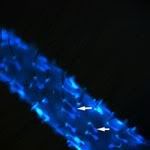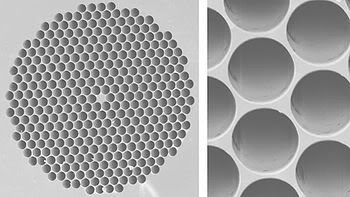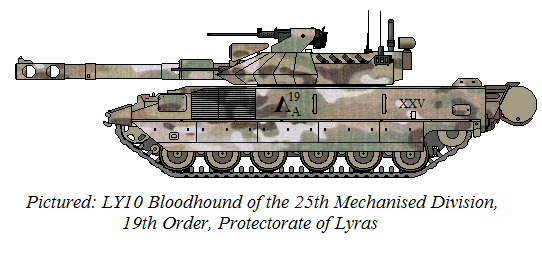
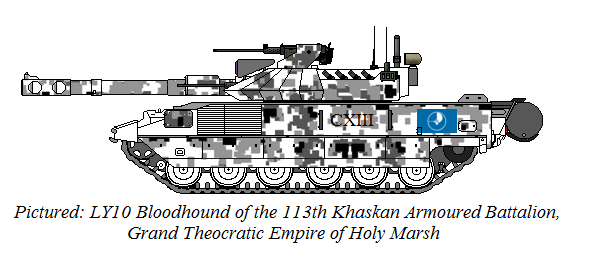
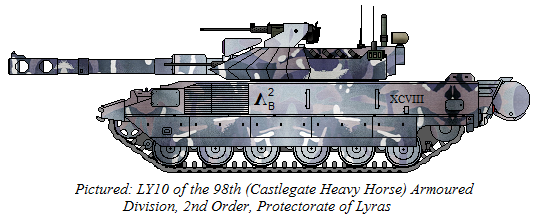
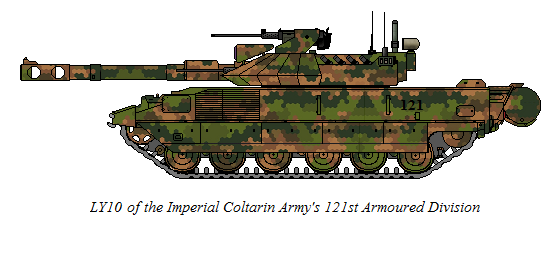
Key Data
Crew: 3 (Driver, Commander, Gunner)
Dimensions
Length (With Gun Forward): 9m
Length (Hull): 6.1m
Height: 2m
Width: 2.8m
Weight: 26 tonnes
Ground Clearance: Variable. Default at 45cm
Performance
Maximum (Governed) Speed: 85kph
Cross Country Speed: 65kph
Speed, 10% Slope: 40kph
Speed, 60% slope: 20kph
Speed, water: 54kph
Acceleration: 0kph to 32 kph in 4.5sec
Range: 480 km (400 km at operational cruising speed)
Manoeuvrability
Vertical Obstacle Crossing: 90cm(36in)
Trench: 2100mm(7ft)
Suspension: Hydropneumatic
Track width: 45cm
Armament
Main Armament: LY415 140mm 30 calibre, ultra-low pressure, rarefaction wave smoothbore (40nds)
Coaxial Weapons: LY60 14.7mm HMG (700 rnds)
Commander's Weapon: 'Acropolis' powered remote rotary platform with LY60 14.7mm HMG (700 rnds)
Additional: 2 x dorsal-lateral grenade launcher racks
Power
Propulsion: LY696, generating 560 HP (747 kW) at 2000RPM.
Transmission: Hydropneumatic automatic transmission (5 fwd gears, 2 rvse)
Power-to-Weight Ratio: 30.77hp/ton
APU: 1 (under armour)
Batteries: 8 x high density Li+ polymer
Armour and Protection
Armour: Titanium, ‘Hauberk' ERA, ‘Acerbitas’ NERA.
Anti-spalling: Dyneema/Resilin
NBC Protection: SCFM, clean cooled air, LYMkII CBRN overpressure system.
Missile Countermeasures: GOLIATH Active Protection System, LA-16 FFR
Background and Conceptualization
As AFV development within the Lyran Protectorate advanced in keeping with known and anticipated threats, the need for a rapidly deployable and highly mobile armoured reconnaissance vehicle and amphibious light tank was realised. The role, previously filled by variants of the LY219 Ironheart AMTV, was determined to be sufficiently important, and requiring of such particular design elements, as to warrant a vehicle specifically built for the purpose. Further, as the Protectorate shifted from a conventional IFV and MBT armoured model to a Light-Medium-Heavy-Assault paradigm, the provision of a ‘light’ component of this spectrum seemed only reasonable. Thus was born the idea and requirement which would come to fruition as the LY10 ‘Bloodhound’ Light Tank.
Shortly after the first submission to the Protectorate Research and Development Commission, it became obvious that currently available materials and technologies would, with adjustment, be able to meet most of the sub-requirements. The advantages of this approach were manifest immediately; development requirements in terms of man-hours would be drastically reduced, and product introduction schedules could be accelerated as a consequence. Elements of AFVs as diverse as the M23 Stingray, Stormer 30 and LY9 have been implemented in the LY10, and the synthesis has thus blended proven technologies with the leading edge of applied force systems to provide reliable and lethal armoured mobility for operation over or in any terrain or environment, with particular reference to the littoral.
The LY10 prototypes were trialled and demonstrated within the Lyran Protectorate, Kingdom of Imbrinium, Holy Marsh and the Federation of Ekraysia, to ensure combat effectiveness across as varied environments as could be reasonably tested. The vehicle’s amphibious capabilities in particular were put through rigorous testing procedures, and careful development and extensive testing was performed at every level, given the Lyran Protectorate’s relative lack of familiarity with this form of littoral warfare.
The LY10 fulfils a variety of military (and/or) peacekeeping functions, providing reconnaissance, fire support, escort, screening, amphibious operational fire support, and support within internal security roles. The fully stabilised, unmanned turret is supplied by the Lyran PR&DC, and is equipped with an unusually high lethality armament for a light tank, by means of the 140mm LY415 30 calibre, low-pressure, rarefaction wave smoothbore, and dual LY60 heavy machine guns. The weapons load out thus provides the LY10 with a nearly unmatched versatility within its role, rendering it capable of engaging threats at all levels of the battlespace.
The Bloodhound can be lifted by CH-53 helicopter, and will fit into a C-130 transport aircraft. It can be moved by commercial truck, on rail flatbed rolling stock, or by an amphibious landing ship. Coupled with the AFV’s amphibious capabilities, the LY10 offers high lethality alongside world-benchmark strategic, tactical and operational mobility.
Shortly after the first submission to the Protectorate Research and Development Commission, it became obvious that currently available materials and technologies would, with adjustment, be able to meet most of the sub-requirements. The advantages of this approach were manifest immediately; development requirements in terms of man-hours would be drastically reduced, and product introduction schedules could be accelerated as a consequence. Elements of AFVs as diverse as the M23 Stingray, Stormer 30 and LY9 have been implemented in the LY10, and the synthesis has thus blended proven technologies with the leading edge of applied force systems to provide reliable and lethal armoured mobility for operation over or in any terrain or environment, with particular reference to the littoral.
The LY10 prototypes were trialled and demonstrated within the Lyran Protectorate, Kingdom of Imbrinium, Holy Marsh and the Federation of Ekraysia, to ensure combat effectiveness across as varied environments as could be reasonably tested. The vehicle’s amphibious capabilities in particular were put through rigorous testing procedures, and careful development and extensive testing was performed at every level, given the Lyran Protectorate’s relative lack of familiarity with this form of littoral warfare.
The LY10 fulfils a variety of military (and/or) peacekeeping functions, providing reconnaissance, fire support, escort, screening, amphibious operational fire support, and support within internal security roles. The fully stabilised, unmanned turret is supplied by the Lyran PR&DC, and is equipped with an unusually high lethality armament for a light tank, by means of the 140mm LY415 30 calibre, low-pressure, rarefaction wave smoothbore, and dual LY60 heavy machine guns. The weapons load out thus provides the LY10 with a nearly unmatched versatility within its role, rendering it capable of engaging threats at all levels of the battlespace.
The Bloodhound can be lifted by CH-53 helicopter, and will fit into a C-130 transport aircraft. It can be moved by commercial truck, on rail flatbed rolling stock, or by an amphibious landing ship. Coupled with the AFV’s amphibious capabilities, the LY10 offers high lethality alongside world-benchmark strategic, tactical and operational mobility.
Main Armament
As is the current Lyran norm, the LY10’s main armament is fitted to an unmanned 360 degree-traverse turret, in a fashion not dissimilar to a very large remote weapon station. The gunner is located in a rotating station, directly below the main gun, and is provided with backup targeting peri-scopes for use if the electronic targeting systems attached to the gunner’s helmet interface fail.
The Bloodhound utilises the purpose-designed LY415 140mm 30 calibre, low-pressure, rarefaction wave smoothbore. The weapon is possessed of an unusual pedigree, stemming from a marriage of several cutting edge technologies. The first conceptual ancestor of the system is the Yanitarian CCA-140 BRETC, which was the first production weapon to feature an ingenious rarefaction wave-based recoil and pressure mitigation system. Aesthetically similar to a recoilless weapon, the principles behind it are not quite the same. Instead of venting propellant gases as they are generated, the weapon opens the breech while the projectile is still travelling down the barrel. This causes a dra-matic drop in chamber pressure as that pressure bleeds off through the open breech. While one would expect that this would compromise projectile acceleration, this is only the case once the front of the pressure loss (rarefaction) wave reaches the projectile. The speed of this wave’s propagation is limited by the speed of sound within the medium. As the speed of sound is lower in a low density gaseous medium than it is in a high density one, this generates an appreciable lag in the time be-tween the chamber venting and the onset of causally linked acceleration and velocity change. In layman’s terms, the propulsion of the projectile can only be compromised after the projectile ‘hears’ the venting. If the projectile has left the muzzle by the time this has taken place, the pressure loss does not negatively impact the projectile at all.
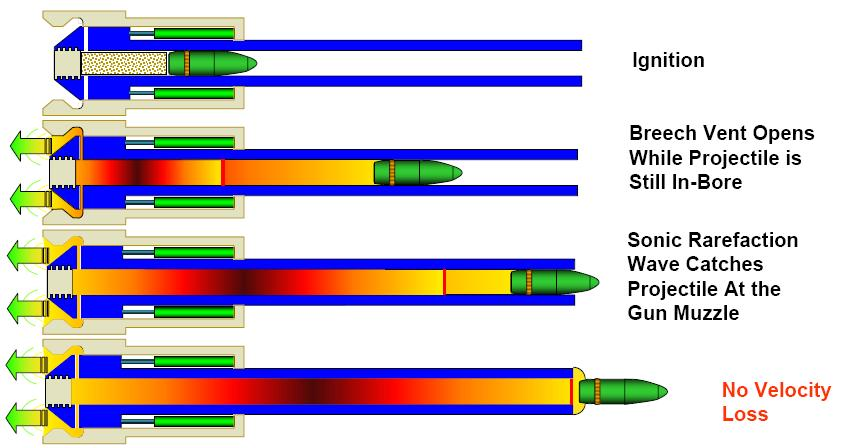
However, the advantage gained by the implementation of this system stems from the very pronounced drop in chamber pressure, with all its respective advantages, including phenomenally decreased recoil forces (50% of normal), appreciably lower barrel heating (60% of normal) and wear, and reduced muzzle flash and blast. These factors, amongst other things, also enable the main ar-mament assembly to be far lighter than its more conventional equivalents, and it is that lightening of weight of primary armament that was the driving factor in the Lyran Protectorate’s decision to implement rarefaction wave technology on the LY10.
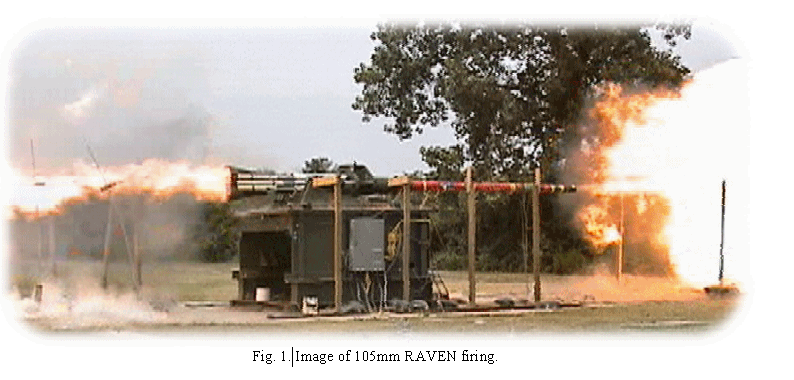
A 500mm recoil mechanism is also present, and it is the rearward recoil motion that activates the ‘venting’ of the chamber (commencing at about 330mm). A high-efficiency muzzle brake is also fitted, so as to lower the felt recoil forces still further.
The Lyro-Lamonian ‘Theophilus’ based upon the Compact Automatic Loader designed by Meggit Defense Systems, Inc, of Irvine, California. The Meggit system, ground-breaking at the time, included a fully articulated robotic transfer unit, which could support a load rate of 12rpm, and boast-ed a magazine access rate of 15rpm.
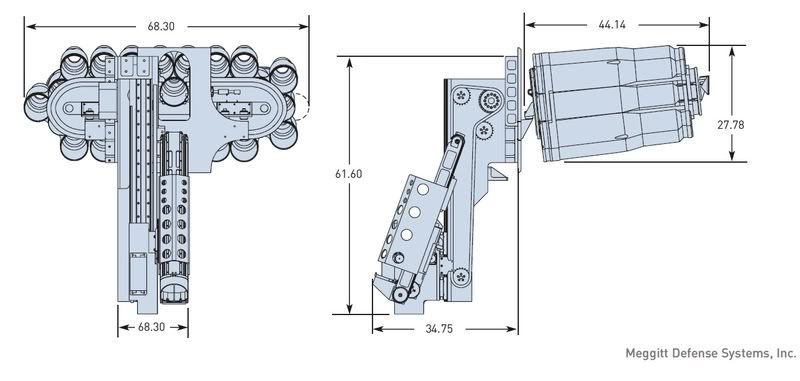
Diagram, Meggit Compact Automatic Loader
Theophilus is very similar to the Meggit design, although rather than making 34 rounds available, the system (due to the larger diameter of the LY415's 140mm rounds) only allows for 20 rounds. As it happens, this has served to accelerate the loading process, even as ammunition available has come down, allowing for burst fire rates of 30.5 rounds per minute (for about 10 seconds), and sustained fire rates of 20.2 rounds per minute. This is partly due to the Meggit design, being as it was intend-ed to slide into an M1 Abrams without impinging upon crew space, presuming the requirement for a loader and gunner in the turret. Theophilus, bereft of such requirements in the Bloodhound (as with the Dire Wolf, which also operates the same loading system), utilises two such-units, thus allowing 40 rounds in total, and allowing for slightly differing layouts to optimise performance. Each sub-unit uses a double-row closed-loop chain of canisters, granting the magazine excellent volumetric storage efficiency. When the gunner selects an ammunition type (using his switch on the control yoke), the nominated round is moved to the blast port by the carousel, whereupon a ram-arm pushes it into the chamber.
Removal of a loaded round is essentially the same process, in reverse, although using a tri-forked extractor, rather than a ram. Theophilus features a full automatic ammunition inventory, and grants very high load speeds, coupled with an exceptional reliability, due to its relatively simple operation.
Made easier by the turret's unmanned design, and in accordance with standing Lyran AFV design philosophy, the autoloader is able to load and extract rounds at any degree of elevation or traverse. Aiming and firing is assisted in operation by the implementation of the Yanitarian YwSCT-500 tur-ret stabiliser, allowing more precise and stable movement, both stationary and while mobile.
Lessons pertaining to operational turn-around time learned from the LY4A1, and applied in the -A2, have been brought over to the LY10, with the Bloodhound’s turret designed to facilitate considerably faster loading. Once the main gun magazine is depleted, the entire turret magazine (consisting of the two separate carousels), can be removed, and a fresh one inserted, a process not dis-similar to changing magazines on a rifle, only on a larger scale. This does require the presence of a dedicated service vehicle, but takes less than 4 minutes. If such a vehicle be unavailable, the system can be reloaded manually/conventionally.
Statistics (LY415):
Weight:
1,560kg Gun barrel,
3,620 kg Gun mount
Barrel length: 4.2m
Caliber: 140mm L/30
Muzzle velocity: 2,570m/s
Range: 8km max @ 30 degrees, 6km Effective
Recoil length: 500mm
Rate of Fire: 30.5 rounds per minute (burst)
20.2 rounds per minute (sustained)
Ready rounds: 40
Variants: LY415
The Bloodhound utilises the purpose-designed LY415 140mm 30 calibre, low-pressure, rarefaction wave smoothbore. The weapon is possessed of an unusual pedigree, stemming from a marriage of several cutting edge technologies. The first conceptual ancestor of the system is the Yanitarian CCA-140 BRETC, which was the first production weapon to feature an ingenious rarefaction wave-based recoil and pressure mitigation system. Aesthetically similar to a recoilless weapon, the principles behind it are not quite the same. Instead of venting propellant gases as they are generated, the weapon opens the breech while the projectile is still travelling down the barrel. This causes a dra-matic drop in chamber pressure as that pressure bleeds off through the open breech. While one would expect that this would compromise projectile acceleration, this is only the case once the front of the pressure loss (rarefaction) wave reaches the projectile. The speed of this wave’s propagation is limited by the speed of sound within the medium. As the speed of sound is lower in a low density gaseous medium than it is in a high density one, this generates an appreciable lag in the time be-tween the chamber venting and the onset of causally linked acceleration and velocity change. In layman’s terms, the propulsion of the projectile can only be compromised after the projectile ‘hears’ the venting. If the projectile has left the muzzle by the time this has taken place, the pressure loss does not negatively impact the projectile at all.

However, the advantage gained by the implementation of this system stems from the very pronounced drop in chamber pressure, with all its respective advantages, including phenomenally decreased recoil forces (50% of normal), appreciably lower barrel heating (60% of normal) and wear, and reduced muzzle flash and blast. These factors, amongst other things, also enable the main ar-mament assembly to be far lighter than its more conventional equivalents, and it is that lightening of weight of primary armament that was the driving factor in the Lyran Protectorate’s decision to implement rarefaction wave technology on the LY10.

A 500mm recoil mechanism is also present, and it is the rearward recoil motion that activates the ‘venting’ of the chamber (commencing at about 330mm). A high-efficiency muzzle brake is also fitted, so as to lower the felt recoil forces still further.
The Lyro-Lamonian ‘Theophilus’ based upon the Compact Automatic Loader designed by Meggit Defense Systems, Inc, of Irvine, California. The Meggit system, ground-breaking at the time, included a fully articulated robotic transfer unit, which could support a load rate of 12rpm, and boast-ed a magazine access rate of 15rpm.

Diagram, Meggit Compact Automatic Loader
Theophilus is very similar to the Meggit design, although rather than making 34 rounds available, the system (due to the larger diameter of the LY415's 140mm rounds) only allows for 20 rounds. As it happens, this has served to accelerate the loading process, even as ammunition available has come down, allowing for burst fire rates of 30.5 rounds per minute (for about 10 seconds), and sustained fire rates of 20.2 rounds per minute. This is partly due to the Meggit design, being as it was intend-ed to slide into an M1 Abrams without impinging upon crew space, presuming the requirement for a loader and gunner in the turret. Theophilus, bereft of such requirements in the Bloodhound (as with the Dire Wolf, which also operates the same loading system), utilises two such-units, thus allowing 40 rounds in total, and allowing for slightly differing layouts to optimise performance. Each sub-unit uses a double-row closed-loop chain of canisters, granting the magazine excellent volumetric storage efficiency. When the gunner selects an ammunition type (using his switch on the control yoke), the nominated round is moved to the blast port by the carousel, whereupon a ram-arm pushes it into the chamber.
Removal of a loaded round is essentially the same process, in reverse, although using a tri-forked extractor, rather than a ram. Theophilus features a full automatic ammunition inventory, and grants very high load speeds, coupled with an exceptional reliability, due to its relatively simple operation.
Made easier by the turret's unmanned design, and in accordance with standing Lyran AFV design philosophy, the autoloader is able to load and extract rounds at any degree of elevation or traverse. Aiming and firing is assisted in operation by the implementation of the Yanitarian YwSCT-500 tur-ret stabiliser, allowing more precise and stable movement, both stationary and while mobile.
Lessons pertaining to operational turn-around time learned from the LY4A1, and applied in the -A2, have been brought over to the LY10, with the Bloodhound’s turret designed to facilitate considerably faster loading. Once the main gun magazine is depleted, the entire turret magazine (consisting of the two separate carousels), can be removed, and a fresh one inserted, a process not dis-similar to changing magazines on a rifle, only on a larger scale. This does require the presence of a dedicated service vehicle, but takes less than 4 minutes. If such a vehicle be unavailable, the system can be reloaded manually/conventionally.
Statistics (LY415):
Weight:
1,560kg Gun barrel,
3,620 kg Gun mount
Barrel length: 4.2m
Caliber: 140mm L/30
Muzzle velocity: 2,570m/s
Range: 8km max @ 30 degrees, 6km Effective
Recoil length: 500mm
Rate of Fire: 30.5 rounds per minute (burst)
20.2 rounds per minute (sustained)
Ready rounds: 40
Variants: LY415
Secondary Armaments
Lyran vehicles, almost universally, are equipped with moderate to heavy secondary armament, and the LY10 is no exception. Due to size constraints, the conventional Lyran coaxial automatic cannon has been removed, and the equally conventional heavy machine gun is now the sole armament mounted coaxially to the main gun. The LY60 heavy machine gun was one of the first weapons designed and produced by Lyras, appearing in both watercooled and aircooled versions. Combat experience demonstrated that the aircooled version was highly suitable for many applications, following a modest increase in the mass of the barrel, and it is in the aircooled version that the LY60 serves today. In AA roles, the LY60 is used on several Lyran AA platforms, and serves as the primary co-axial weapon of the LY2 Mastiff series, and as the secondary coaxial on the LY7. The weapon is a belt fed, short recoil operated, open bolt, fully automatic weapon. Metallic disintegrating link belts can feed it from either the left or right of the reciever. The quick change barrel is removable with the barrel jacket as a unit. The bore is chromium plated to increase barrel life and durability. The weapon fires the the LY112 14.7 x 115mm cartridge. The LY60 has a maximum effective range of 1400m against air targets, and 2200m against ground targets. The standard firing controls consist of a push-type thumb trigger and sear release buttons located between the dual spade grips. Alternatively, an electric trigger can be installed for mounted vehicle applications. The gun is simple in design and rugged in construction, and considered one of the most reliable heavy machine guns in service anywhere in the world.
The LY60 entered mass production as an infantry support weapon, with a tripod mount designed at the Lughenti Test Range. Within three years, the heavy Lughenti Type-I mount was replaced by a lighter design, and it is the Type-II that continues to see service within Lyran infantry formations. Guns produced prior to the arrival of the Type II mount have been retrospectively upgraded.
The infantry version of the LY60, however, had a relatively short primacy within Lyras, being re-placed in numerical majority by the version fielded as primary armament for several LY219 variants. It also finds use in several anti-aircraft roles, alongside the KWF PAK2 25mm cannon.
Very similar to the Soviet-designed KPV, the LY60 provides almost double the muzzle energy of a conventional 12.7mm (ie, .50 caliber) weapon. With muzzle velocities between 960 - 1030 meters per second and bullet weights near 60grams, the LY60 generates muzzle energy of about 32 kilojoules, and, again similarly to the KPV, penetrated over 30mm of steel armor at 500 meters range and approximately 20mm at 1000 meters.
As with the LY9, the commander’s weapon is mounted on the Yanitarian designed 'Acropolis' RWS. The SNMAE made "Acropolis" RWS is an all new design meant to be integrated with existing and future military technology. Also able to accommodate previous generation heavy machine guns such as the EL-1, ML-147, M-2HB, and Kord 14.5mm, the Acropolis consist of three parts, the interface section, the sensor, and the weapon mount.
The sensor suite used on the Bloodhound’s Acropolis mount is the YwVE-33ML which combines day/night infrared sights with laser range finding for land and naval operations, and is much quieter that previous systems, being inaudible from 50m away (and although this seems ridiculous, this is in fact very good). LY4A2 Wolfhound and CA-39MqIX tanks (both AFVs with extremely low detection footprints), the YwVE-33ML has an 8.1km detection range and a 3.1km recognition range, while the laser range finder is typically good up to more than five kilometres, well out of the engagement range of most weapons which would rely on the RWS's sensory capability, rather than the wider platform's. The YwVE-33ML is meant to be used in multiple applications as a standalone system, with the Acropolis simply being the first. The YwVE-33ML, as one would expect, provides data to the vehicle’s Cromwell system. The total system weighs 100kg and is largely made out of titanium in order to save weight.
The Bloodhound, as with nearly every Lyran AFV also mounts two lateral grenade launchers. Each launcher is electronically-fired, and consists of four barrels which can be intermixed with either smoke, fragmentation or chaff grenades. The smoke grenades are capable of shrouding the tank from visual or thermal detection and the chaff grenades are utilised as a means of breaking up the tank's radar cross-section. Both of these measures work most effectively in conjunction with the 'Warshroud' system to maximise operational performance.
The LY60 entered mass production as an infantry support weapon, with a tripod mount designed at the Lughenti Test Range. Within three years, the heavy Lughenti Type-I mount was replaced by a lighter design, and it is the Type-II that continues to see service within Lyran infantry formations. Guns produced prior to the arrival of the Type II mount have been retrospectively upgraded.
The infantry version of the LY60, however, had a relatively short primacy within Lyras, being re-placed in numerical majority by the version fielded as primary armament for several LY219 variants. It also finds use in several anti-aircraft roles, alongside the KWF PAK2 25mm cannon.
Very similar to the Soviet-designed KPV, the LY60 provides almost double the muzzle energy of a conventional 12.7mm (ie, .50 caliber) weapon. With muzzle velocities between 960 - 1030 meters per second and bullet weights near 60grams, the LY60 generates muzzle energy of about 32 kilojoules, and, again similarly to the KPV, penetrated over 30mm of steel armor at 500 meters range and approximately 20mm at 1000 meters.
As with the LY9, the commander’s weapon is mounted on the Yanitarian designed 'Acropolis' RWS. The SNMAE made "Acropolis" RWS is an all new design meant to be integrated with existing and future military technology. Also able to accommodate previous generation heavy machine guns such as the EL-1, ML-147, M-2HB, and Kord 14.5mm, the Acropolis consist of three parts, the interface section, the sensor, and the weapon mount.
The sensor suite used on the Bloodhound’s Acropolis mount is the YwVE-33ML which combines day/night infrared sights with laser range finding for land and naval operations, and is much quieter that previous systems, being inaudible from 50m away (and although this seems ridiculous, this is in fact very good). LY4A2 Wolfhound and CA-39MqIX tanks (both AFVs with extremely low detection footprints), the YwVE-33ML has an 8.1km detection range and a 3.1km recognition range, while the laser range finder is typically good up to more than five kilometres, well out of the engagement range of most weapons which would rely on the RWS's sensory capability, rather than the wider platform's. The YwVE-33ML is meant to be used in multiple applications as a standalone system, with the Acropolis simply being the first. The YwVE-33ML, as one would expect, provides data to the vehicle’s Cromwell system. The total system weighs 100kg and is largely made out of titanium in order to save weight.
The Bloodhound, as with nearly every Lyran AFV also mounts two lateral grenade launchers. Each launcher is electronically-fired, and consists of four barrels which can be intermixed with either smoke, fragmentation or chaff grenades. The smoke grenades are capable of shrouding the tank from visual or thermal detection and the chaff grenades are utilised as a means of breaking up the tank's radar cross-section. Both of these measures work most effectively in conjunction with the 'Warshroud' system to maximise operational performance.


